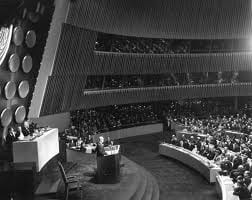 |
 |
| 1. Eisenhower announces the program at the UN, December 1953 | 2. Eisenhower visits the US swimming pool reactor on display in Geneva, July 1955 |
1. John Krige, “The Politics of Phosphorus-32. A Cold War Fable Based on Fact,” Historical Studies in the Physical and Biological Sciences, 36:1 (2005), 71-91.
Treats radio-isotopes for medicine as instruments to win hearts and minds in a divided Italy in 1949. By constructing a narrative around one shipment it satisfied my fascination with the ability of archaeologists to tell a story about the past using fragmentary evidence. For a pdf click here
2. John Krige “Atoms for Peace, Scientific Internationalism, and Scientific Intelligence,” in John Krige and Kai-Henrik Barth, eds, Global Knowledge Power. Science and Technology in International Affairs, Osiris 21 (University of Chicago Press, 2006), 161- 181.
Situates the 1955 conference in Geneva in historical context and shows how it was instrumentalized by both Soviet and US scientists and policymakers. For a pdf click here
3. John Krige, “Techno-Utopian Dreams, Techno-Political Realities. The Education of Desire for the Peaceful Atom,” in Michael D. Gordin, Helen Tilley and Gyan Prakash, eds, Utopia/Dystopia. Conditions of Historical Possibility (Princeton University Press, 2010), 151-175.
Explores the dissemination of the peaceful use of the atom to ‘power-starved areas of the globe’ taking off from Homi Bhabha’s Presidential address in Geneva 1955. For a pdf click here
4. John Krige, “The Peaceful Atom as Political Weapon: Euratom as an Instrument of U.S. Foreign Policy in the 1950s,” Historical Studies in the Natural Sciences 38:1 (2008), 5-44.
How the US hoped to use its leadership in civilian nuclear power to accelerate European integration. For pdf click here